Isotope and DNA analysis of archaeological remains offer new insights into the diets and origins of ancient populations. Emma Davies digs up more information
Isotope and DNA analysis of archaeological remains offer new insights into the diets and origins of ancient populations. Emma Davies digs up more information

Kwäday Dän Ts'ìnchi is young, restless and yearns to explore. He throws a squirrel fur robe over his shoulders, dons a spruce hat and packs his beaver skin bag with goodies before trudging slowly on a long journey across the planet’s icy north. He pauses occasionally to rest and to drink deeply from glacial water. But then his life is cut tragically short, perhaps by the extreme cold. Over 300 years later - in 1999 - Canadian sheep hunters in British Columbia stumble across Kwäday Dän Ts'ìnchi’s dismembered body strewn across the ice, released from its melting glacial tomb.
The mysterious young man’s body and clothing had been beautifully preserved. He was given the name Kwäday Dän Ts'ìnchi, which translates from Southern Tutchone as ’long ago person found’, and an international team of researchers set to work unearthing his story. DNA analysis identified 17 current-day relatives on Kwäday Dän Ts'ìnchi’s mother’s side. His stomach was found to contain pollen from coastal salt marshes and fragments of a shell fish, suggesting a meal sourced from the coast. Meanwhile, his bag still contained the remains of a sockeye salmon. Had Kwäday Dän Ts'ìnchi travelled from the coast and what had he eaten? Isotopes of carbon and nitrogen in his body held the key.
Stable isotope ratios are routinely used by archaeologists and forensic teams hoping to unravel ancient diets and migratory behaviour. Analytical techniques are advancing at such a pace that archaeological chemistry is flourishing and researchers find themselves able to delve ever deeper into the long distant past.
Isotopic insight
The science is based on the idea that you are what you eat. ’Our skeleton, like all body tissues, is formed and maintained from the basic molecular components of the food we consume,’ explains Gundula Müldner, a bioarchaeologist from the University of Reading, UK. ’Significant dietary information is therefore encrypted in our bones.’
Broad food types can be characterised by their stable isotope signatures. All foods contain carbon, which has three naturally occurring isotopes: 12 C, 13 C and 14 C. Carbon-14 decays over time and is used for radiocarbon dating but the other two isotopes are eternally stable. The ratio of 13 C to 12 C (known as δ13C,) in bone constituents such as collagen does not change after death, and so its dietary information is forever held intact. Marine foods have high carbon isotope ratios that set them apart from foods produced on land.
Meanwhile, nitrogen stable isotope ratios reflect an animal’s position in the food chain. The ratio of 15 N to 14 N (δ15 N) generally increases incrementally from food source to consumer and so carnivores have higher δ15 N values than the herbivores that they eat. Marine mammals are at the top of a very long food chain and have very high δ15 N values.
Carbon studies can also hint at the kind of plants that have been eaten. Most plants, especially in Europe, fall into the C3 category (three carbon atoms in the first product of carbon fixation from photosynthesis) but those adapted to survive in arid climates are often classed as C4, including millet and sugar cane. These foods have distinctive isotope ratios which are passed on to the body.
Such C4 plants recently gave Müldner a scientific breakthrough in her work on the famous ’Headless Romans’ buried in a Roman cemetery in York, UK. There, more than half of the men buried had been decapitated and their heads placed next to them. Given the cemetery’s distinctive burial practice, one might have assumed that all the people buried there had come from the same place.
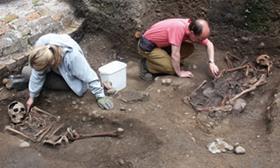
Müldner’s team recorded the carbon, nitrogen, oxygen and strontium isotope ratios in bone collagen and tooth enamel and was
surprised to discover that two of the men had consumed large amounts of C4 plants (probably millet). As millet was not grown in the UK at the time it can be concluded that the two men had travelled long distances to get to York. The C4 signatures are the first to be recorded in British archaeology, says Müldner. ’It is a most exciting discovery.’
Ice man isotopes
Meanwhile, Richard Evershed’s team from the chemistry department at the University of Bristol in the UK was lucky enough to work on Kwäday Dän Ts'ìnchi’s remains. The researchers found very high carbon isotope ratios in the bone collagen - similar to those found in polar bears - indicating that he had feasted on marine foods for most of his life. His bone lipids contained the breakdown products of two long chain fatty acids closely associated with a seafood diet - something that had been observed before in Greenland’s Eskimos.

So the ice man had almost certainly lived at the coast, but how would his trek inland affect his isotope ratios? At this point Evershed and his team moved on to skin samples. Living bone takes at least a year to renew itself whereas we get new skin over a timescale of weeks; comparing the isotope ratios can therefore reveal sudden changes in diet. Sure enough, isotopic analysis of fatty acids in the skin indicated that he had eaten less fish and more plants in the final weeks of his life.
Break from the norm
Routine carbon and nitrogen stable isotope analysis is commonly done on bone collagen, giving average signals over all of the amino acids - known as ’bulk’ signals. ’The bulk signal is a huge integration,’ says Evershed. ’We have spent about 40 years recording bulk isotope values with surprisingly little understanding of where the signals come from,’ he says.
Evershed’s team is pulling collagen apart to the amino acid level to understand what the bulk isotope signals really reveal and how nitrogen and carbon signals are constructed in bone. ’Different amino acids display different isotope values so you can appreciate how the bulk signal is actually formed and you also start to see differing patterns depending on diet,’ explains Evershed.
Kwäday Dän Ts'ìnchi was the perfect subject for such amino acid work. Comparing his bone and skin amino acids again highlighted the shift from a long-term seafood diet to more terrestrial and freshwater resources towards the end of his life. The work also gave Evershefd and his team a new ’proxy for marine protein consumption’.
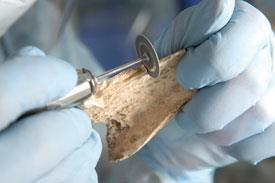
’It seems to work in other places as well,’ says Evershed, who next turned his focus on Africa in a bid to understand where the marine isotope signature was coming from. He and fellow Bristol geochemist Amy Styring teamed up with an archaeologist from the University of Cape Town to study ancient bones from South Africa. The region is particularly valuable to researchers looking for clear differences in bone composition because of its clearly distinct climate zones, ranging from highly arid to pretty wet. There is also a marine-rich region.
South Africa has been extensively studied previously, using bulk isotope values. However, carbon isotope ratios can be of limited value in very dry regions because diets rich in the native C4 plants frequently give values that overlap with those from marine rich diets. This time Evershed’s team used δ15 N values, which although tricky to measure are hugely valuable in painting a picture of the past.
Acid test
Amino acids have different nitrogen isotope ratios depending on their biosynthetic origins. As you go up the food chain δ15 N values for some amino acids, such as glutamate, increase significantly. Others, such as phenylalanine, which cannot be synthesised by the body, give δ15 N values that remain essentially unchanged through the food chain, and can be taken to represent its base. As Evershed discovered, the differences in δ15 N values of glutamate and phenylalanine (Δ 15 NGlu-Phe) can therefore give a good idea of where the animals that humans have fed on sat in the food chain. Marine-rich diets in particular stand out beautifully.
Evershed’s team extracted the collagen from the ancient South African bones and hydrolysed it to get at the amino acids, which were analysed using GC-C-IRMS (gas chromatography-combustion-isotope ratio mass spectrometry). The researchers also measured isotope ratios in the kinds of foods that the people would probably have eaten.
’We stumbled across a very interesting phenomenon with the way that amino acids are routed from the marine environment,’ says Evershed. ’They have a very unusual signature which we are still trying to get to the bottom of.’ From work on tortoises, the remains of which are common in South African archaeological sites, Evershed believes it may be possible to distinguish between some organisms based on metabolic differences. Tortoises excrete nitrogen in the form of uric acid as well as urea, giving negative δ15 NGlu-Phe values whereas those for marine and terrestrial mammals - which metabolise most of their nitrogen to urea - are positive.
Crime scene investigation
Archaeologists and forensics teams often seek the same information, using the same techniques - all that differs is the age of the remains. Matthew Collins from the University of York, UK, is often asked by archaeologists if he can tell whether bones have been cooked, either to see which animals have been kept for their meat or to gain evidence of cannibalism.
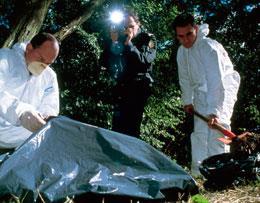
But he wasn’t expecting the call from a police team asking for help with a murder case where a man was suspected of roasting his wife’s head. ’They wanted us to say "yes, I can see that this bone has been cooked,"’ recalls Collins. ’We couldn’t answer the question - we couldn’t tell the difference between changes from cooking and changes happening in the ground,’ he adds. Hannah Koon, now at Harvard University, US, worked with Collins, using transmission electron microscopy to reveal that mild cooking subtly changes collagen’s structure.
Meanwhile, a team led by Richard Evershed at the University of Bristol, UK, was contacted by London’s Metropolitan Police force, who needed proof that a murder victim had lain in a recently emptied grave. The researchers were provided with white particulate matter and soil samples from the grave site and, when a torso was recovered, with body fat samples. For control purposes, they also received body fat samples from the body farm at the University of Tennessee, US, which monitors the chemical decomposition of human bodies in different burial surroundings. Carbon isotope analysis of two of the fatty acids showed that the remains were human rather than animal and linked the grave to the murder victim. The work helped to secure a conviction.
Bone loss
For most collagen analysis, bone destruction is unavoidable. A team led by Matthew Collins at the University of York, UK, has found a gentle, non-destructive way to extract the collagen from bone by soaking it in buffered warm water. The technique proved invaluable in tests on a set of Viking and iron age combs from Orkney, Scotland. Archaeologists were keen to know whether the antlers used to make the combs had been sourced locally or imported from Scandinavia, and turned to Collins for the answer. He was tasked with discovering whether reindeer and/or red deer antlers had been used. Reindeer were not native to Scotland but would have been abundant in Scandinavia at the time. Collins’ team was able to extract the collagen in water and identified both reindeer and red deer antlers in the combs, giving them a distinct Viking flavour.
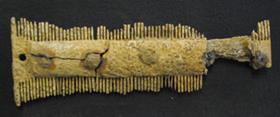
For the project Collins used a technique developed at York called ZooMS (Zooarchaeology by mass spectrometry) which essentially records protein fingerprints in bone collagen. Collagen is extracted, purified and analysed using MS. By comparing the peptide fingerprints with those from previously analysed samples, it is possible to identify which species a bone has come from. Collins’ team has built up a library of collagen sequences to compare new samples against and has already been able to use ZooMS to distinguish between sheep and goat bones.
According to Collins, ZooMS promises to be invaluable to archaeologists, offering them a way to identify ancient bones that are too damaged to be classified by sight. He hopes that the technique could even be used to identify bones of animals that became extinct as modern humans migrated across the globe from Africa 70 000 years ago. He suggests that ZooMS will allow collagen to be used as a ’molecular barcode’ long after DNA has degraded beyond analysis.
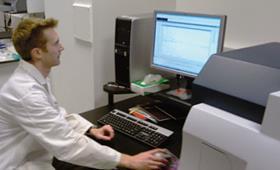
DNA dates
Tom Gilbert, an expert on ancient DNA at the University of Copenhagen in Denmark, agrees that getting good DNA samples from truly ancient bones is not easy. ’When animals die, cell death smashes up the DNA and RNA,’ he explains.
Nevertheless, he doesn’t actually need much DNA to work on. New analytical methods have made a tremendous difference to his work. With the old polymerase chain reaction (PCR) methods, researchers would need at least 80-90 base pair DNA fragments to sequence. With new methods, all that is needed is approximately 50 base-pair fragments. ’It has been a really big breakthrough to get the machines that allow us to do 40-50 base pairs,’ he says.
In 2008, Spanish researchers reported sequencing DNA from 400,000 year old cave bear bones. But that’s as far back as anyone has gone with DNA. ’What you find is that the older bone gets the shorter the DNA becomes,’ explains Gilbert. ’I’d be surprised if you could get any DNA older than 500,000 years,’ he says. Even then, DNA preservation is very temperature dependent, surviving for a long time in cold climes. ’I am extremely sceptical of all the ancient Egypt work that reports finding DNA,’ says Gilbert. ’It is too hot there.’
Back at the University of York, Collins would love to be able to use collagen to date archaeological samples beyond the 60,000 year limit of radiocarbon dating. Many of the questions that archaeologists pose lie at the radiocarbon limit, he says. ’In the high Arctic, preservation [of bone] is fantastic and we have been trying to find a way to date collagen. We have also been trying like crazy to get some kind of chemical signal of decay to age teeth, which have lovely collagen molecules,’ he says.
’There’s a huge pressure to get a method that goes beyond radiocarbon and many people have tried many different things,’ says Collins. His team is on its ’final attempt’ and he has had three failed student projects trying to get a date from collagen amino acids, based on their chirality. In all living organisms, proteins are almost exclusively made from the left-handed (L) amino acids but after death the numbers of left- and right-handed (D) amino acids even out. Collins is collaborating with fellow York researcher Kirsty Penkman, whose team is busy working on a chiral separation of amino acids using high performance liquid chromatography (HPLC) to measure ratios of L to D amino acids. She has had great success dating shells using this approach.
Collins is also carrying out isotope research for the Jorvik Viking Centre, a museum in York, for an exhibition scheduled for February 2011. The exhibition will illustrate to the general public the wealth of life information that can be extracted from two Viking skeletons excavated locally. Several leading researchers, including Reading’s Müldner, are involved in analysing the bone samples. The results, which will be published at the exhibition, will provide a perfect example of how chemistry is delivering a bold and bright picture of our ancient history.
Emma Davies is a freelance science writer based in Bishop’s Stortford, UK
Additional information
L T Corr et al, J. Archaeol. Sci., 2008, 35, 2102
L T Corret al, J. Archaeol. Sci., 2009, 36, 12
M Collins et al, Spectrosc. Eur., 2010, 22, 6
G Müldner et al, J. Archaeol. Sci., 2010, in press
K Penkman, J. Quaternary Sci., 2009, DOI: 10.1002/jqs.1346
I D Bull et al, Sci. Justice, 2009, 49, 142
H E C Koonet al, J. Archaeol. Sci., 2010, 37, 62






No comments yet